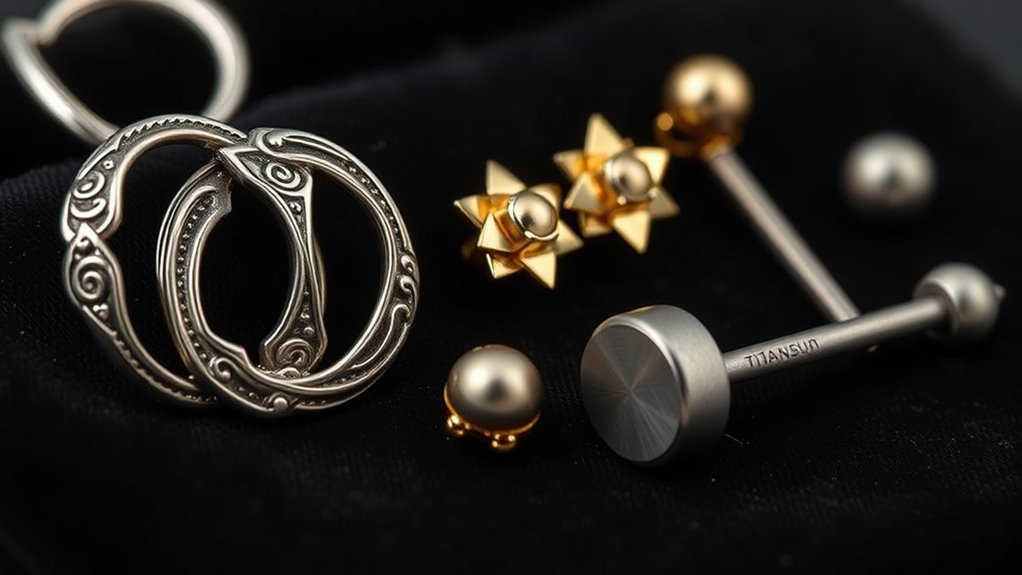Over time, piercing jewelry materials have shifted from simple metals to advanced, hypoallergenic options like titanium, surgical stainless steel, and high-karat gold. Today, many pieces are ethically sourced, recycled, and conflict-free, supporting environmental and social responsibility. These modern materials also reduce allergy risks, ensuring safer, more comfortable piercings for sensitive skin. If you want to explore the full story behind these exciting developments, there’s more to discover about how jewelry continues to evolve.
Key Takeaways
- Early piercing jewelry used simple metals, evolving toward more durable and aesthetically appealing materials over time.
- Increasing demand for ethical sourcing led to the use of recycled metals and conflict-free materials.
- Hypoallergenic options like surgical stainless steel, titanium, and high-karat gold became standard for sensitive skin.
- Innovations in manufacturing improved jewelry safety, strength, and comfort, supporting healthier piercing experiences.
- Modern materials emphasize sustainability, reducing environmental impact while enhancing durability and style.

Have you ever wondered what your piercing jewelry is made of? The materials used have come a long way, evolving from simple metals to sophisticated, ethically sourced options. Today, many people prioritize not only the look and durability but also the ethical and health aspects of their jewelry. This shift has led to increased awareness about sustainable sourcing, ensuring that materials are obtained responsibly without harming the environment or local communities. For instance, some manufacturers now emphasize recycled metals or materials sourced from conflict-free zones, giving you peace of mind that your jewelry supports ethical practices. These sustainable options are gaining popularity because they align with a growing desire for environmentally conscious choices.
In addition to sustainability, there’s been a significant focus on hypoallergenic options. If you have sensitive skin or are prone to allergic reactions, selecting jewelry made from hypoallergenic materials is *vital*. Traditional metals like nickel, which was once common in jewelry, can cause irritation or allergic responses. As a result, you now have access to a variety of hypoallergenic materials such as surgical stainless steel, titanium, niobium, and certain types of gold. These materials are less likely to cause adverse reactions, making them ideal for ongoing wear, especially for new piercings. The evolution of piercing jewelry materials reflects a better understanding of individual health needs and a commitment to safer, more comfortable options.
The shift toward hypoallergenic options has also driven innovation in jewelry manufacturing. For example, titanium has become a favorite due to its strength, lightweight nature, and hypoallergenic properties. It’s often used in initial piercings because it minimizes the risk of irritation. Similarly, surgical stainless steel offers durability and affordability while maintaining biocompatibility. Gold, particularly high-karat varieties, is also popular since it’s less likely to contain allergenic metals. These advancements mean you can choose jewelry that not only looks good but also supports your skin’s health. Additionally, the development of surgical-grade materials has further enhanced the safety and comfort of modern piercing jewelry.
Frequently Asked Questions
Are Rare or Exotic Materials Used in Piercing Jewelry?
Yes, you can find piercing jewelry made from rare materials and exotic alloys. These unique options often include things like titanium with special finishes, surgical steel with rare coatings, or even ethically sourced exotic woods and stones. Using rare materials adds a distinctive touch to your jewelry, making it stand out. Just make sure that your piercer confirms the safety and hypoallergenic qualities of these exotic alloys before you get pierced.
How Do Materials Affect Healing Time and Tissue Reaction?
Think of your piercing as a delicate garden; the right materials are the nourishing soil helping it thrive. Using biocompatible materials reduces tissue reactions and speeds healing, while durable options prevent irritation from daily wear. If the material isn’t compatible or isn’t durable, expect longer healing times and possible complications. Choosing high-quality, biocompatible jewelry minimizes concerns, supporting your body’s natural healing process and keeping your piercing healthy and happy.
Can Materials Be Recycled or Sustainably Sourced?
Yes, materials can be recycled and sustainably sourced. You should look for jewelry brands that prioritize recycling practices, like using recycled metals or ethically sourced gemstones. By choosing these options, you’re supporting sustainable sourcing, reducing environmental impact, and promoting responsible production. Always check the company’s transparency about their sourcing methods and recycling efforts to guarantee your piercing jewelry aligns with eco-friendly values.
Are There Specific Materials Better for Sensitive Skin?
Ever wondered which materials are best for sensitive skin? You should choose hypoallergenic options like surgical steel, titanium, or niobium, as they’re known for being skin-friendly metals. These materials reduce irritation and allergic reactions, making your piercing experience more comfortable. Always check for nickel-free labels, and avoid cheap alloys. Isn’t it worth investing in jewelry that protects your skin while looking great? Opt for high-quality, skin-friendly metals for peace of mind.
What Innovations Are Emerging in Piercing Jewelry Materials?
You’ll notice new innovations in piercing jewelry materials like biocompatible alloys and innovative polymers. These advancements improve safety and comfort, especially for sensitive skin. Biocompatible alloys, such as titanium and surgical steel, reduce allergic reactions, while innovative polymers offer lightweight, hypoallergenic options. As technology advances, expect more durable, flexible, and skin-friendly materials to emerge, making piercings safer and more enjoyable for everyone.
Conclusion
As you explore the world of piercing jewelry, remember that each material tells a story—like a shimmering thread woven through your skin’s tapestry. From the ancient glints of gold to modern, biocompatible marvels, these choices shape your unique expression. Think of your jewelry as a silent symphony, every piece playing its part in your personal masterpiece. Ultimately, the right material becomes an extension of you—beautiful, resilient, and forever evolving.















